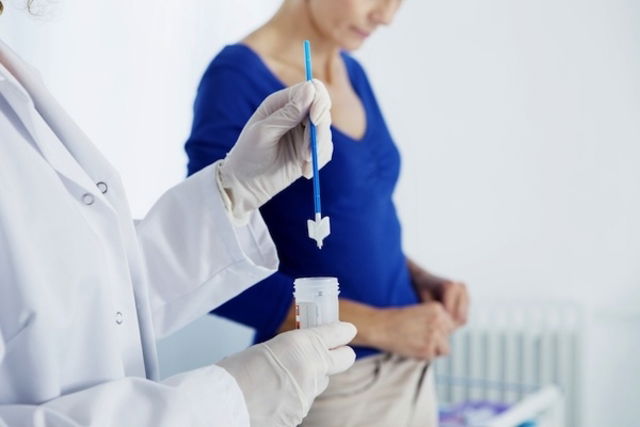Uterine pain can occur during your menstrual cycle due to an increased production of prostaglandin. This substance is responsible for pain sensations and leads to increased uterine contractions to promote shedding of the uterine lining, which characterizes menstruation.
Uterine pain that occurs outside o a period and presents with other symptoms, like discharge, breakthrough bleeding, abdominal pressure, pain during sex, bloating and urinary urgency may be a sign of another condition however. Conditions that present with these types of symptoms include uterine inflammation, endometriosis, adenomyosis, and uterine polyps.
If you feel constant uterine pain that does not improve with time and presents with other symptoms, you should see a gynecologist for assessment. The doctor may order testing to help identify the underlying cause and start treatment as necessary.

What causes uterine pain?
Uterine pain may ocur due to:
1. Menstruation
Uterine pain commonly occurs during menstruation, as this time is associated with an increased production of prostaglandins. These are inflammatory substances that prmote uterine contraction and promote shedding of the uterine wall (also known as the endometrium), which results in a period.
What to do: Uterine pain from menstruation is considered to be normal and does not require any type of treatment. Very intense pain that interferes with activities of daily living should be assessed by a gynecologist, however. The doctor may prescribe medication to relieve pain and discomfort.
2. Pelvic inflammatory disease (PID)
PID is an inflammation of the uterus that is caused by microorganisms that entered through the vagina. It is associated with symptoms like pain, vaginal discharge, pain during sex and breakthrough bleeding.
What to do: Treatment for PID should be monitored by a gynecologist, who may prescribe antibiotics depending on the infectious agent causing inflammation.
3. Endometriosis
Endometriosis is a condition associated with abnormal growth of endometrial tissue in areas of the body outside of the uterus. It causes uterine pain, particularly during a period, pain during sex and increased menstrual flow.
Read more about the symptoms of endometriosis and how they can vary from woman to woman.
What to do: It is important to follow treatment as outlined by your gynecologist. He or she may prescribe anti-inflammatories to relieve symptoms, as well as hormonal medication or even surgery in severe cases.
4. Adenomyosis
Adenomyosis is characterized by abnormal thickening of the uterine walls. It can cause pain, which can be intense during a period, bloating, pain during sex and heavy menstrual flow.
What to do: You should consult a gynecologist for diagnosis and treatment, which is usually aimed at symptom relief with medications. In severe cases, the doctor may recommend surgical removal of the uterus.
5. Uterine myoma
A uterine myoma is a type of benign tumor that can form within the muscle tissue of the uterus. In most cases, it does not cause symptoms. However, myomas that are very large or multiple myomas can cause uterine pain, particularly during sex, as well as constipation and a longer period.
What to do: A gynecologist may prescribe anti-inflammatory medications, hormones, iron supplements or surgery to remove myomas.
6. Uterine polyps
A uterine polyp is similar to a cyst that grows on the uterine walls. It can cause pain in some women, as well as an irregular period, heavy flow during a period, and bleeding after sex.
What to do: In most cases, treatment is not necessary and myomas are just monitored by the gynecologist. Pain can be managed with medication, while very large, symptomatic polyps can be surgically removed.
Tests for uterine pain
Generally, the gynecologist may order testing to determine the underlying cause of pain in the uterus. Some of the most commonly ordered tests include:
- Vaginal inspection: The doctor will insert two gloves fingers into the vagina while pressing down on the abdomen to evaluate reproductive organs. This may help to diagnose endometriosis and pelvic inflammatory disease.
- Speculum exam: A speculum is inserted into the vagina to evaluate for the presence of discharge or bleeding.
- Pap test: This test is used to detect cancerous cells in the cervix and uterus. A speculum is introduced into the vagina and a brush is used to collect a sample of cells to be analyzed in the lab. Learn more about the pap smear and what it tests.
The doctor may additionally order and ultrasound or MRI, depending on the woman's symptoms, to further confirm or rule out certain conditions. Most times, invasive tests are only prescribed if the woman is sexually active.
